Impact of Al2O3 Particle Size on the Open Porosity of Ni/Al2O3 Composites Prepared by the Thermal Oxidation at Moderate Temperatures
Abstract
:1. Introduction
2. Materials and Methods
2.1. Powder Samples
2.2. The Thermal Oxidation of Powder Mixtures
2.3. Thermogravimetric (TG) Measurement
2.4. Measurement of the Open Porosity
2.5. Analyses of the Microstructure and Chemical Composition
2.6. Flexural Strength Testing
3. Results and Discussion
3.1. TG Measurement
3.2. Impact of the Sample Weight and Dimensions
3.3. Correlation between Weight Gain and Open Porosity
3.4. NiO Amount and NiO Thickness Related to Open Porosity
3.5. Flexural Strength
4. Conclusions
Author Contributions
Funding
Data Availability Statement
Acknowledgments
Conflicts of Interest
References
- Li, H.; Liu, R.; Chen, J.; Wang, Z.; Xiong, X. Preparation of nickel porous materials by sintering nickel oxalate and sodium chloride after blending and reduction. J. Mater. Res. Technol. 2020, 9, 3149–3157. [Google Scholar] [CrossRef]
- Bhattacharyya, M.; Kumar, A.N.; Kapuria, S. Synthesis and characterization of Al/SiC and Ni/Al2O3 functionally graded ma-terials. Mater. Sci. Eng. A 2008, 487, 524–535. [Google Scholar] [CrossRef]
- Yang, S.; Kim, H.; Lee, C.S. Investigation of shrinkage control in Ni–Al2O3 (metal–ceramic) functionally graded materials. Ceram. Int. 2013, 39, 93–99. [Google Scholar] [CrossRef]
- Dele-Afolabi, T.T.; Azmah Hanim, M.A.; Norkhairunnisa, M.; Sobri, S.; Calin, R.; Ismarrubie, Z.N. Significant effect of rice husk and sugarcane bagasse pore formers on the microstructure and mechanical properties of porous Al2O3/Ni composites. J. Alloys Compd. 2018, 743, 323–331. [Google Scholar] [CrossRef]
- Li, Y.-b.; Yue, W.-x. Study on the Al2O3 contents in Ni–Al2O3 composite coatings predicted by using BP neural network model. J. Synth. Crys. 2017, 8, 1649–1652. [Google Scholar]
- Fan, H.; Jiang, J.; Zhao, Y.; Wang, S.; Li, Z. Improvement of microstructure and properties of Ni–Al2O3 composite coating via jet electrodeposition. J. Mod. Phys. B 2020, 34, 2050243. [Google Scholar] [CrossRef]
- Alekseeva, E.; Shishkova, M.; Strekalovskaya, D.; Gerashchenkov, D.; Glukhov, P. Ni-Bbsed coatings for oil and gas industry fabricated by cold gas spraying. Mater. Proc. 2021, 3, 2. [Google Scholar] [CrossRef]
- Amosov, A.P.; Titova, Y.V.; Timoshkin, I.Y.; Kuzina, A.A. Fabrication of Al-AlN nanocomposites. Key Eng. Mater. 2015, 684, 302–309. [Google Scholar] [CrossRef]
- Aryshnskii, E.V.; Bazhin, V.Y.; Kawalla, R. Strategy of refining the structure of aluminum magnesium alloys by complex microalloying with transition elements during casting and subsequent thermomechanical processing. Non-Ferr. Met. 2019, 1, 28–32. [Google Scholar] [CrossRef]
- Li, B.; Zhang, W.; Li, D. Synthesis and properties of a novel Ni–Co and Ni–Co/ZrO2 composite coating by DC electrodeposi-tion. J. Alloys Compd. 2020, 821, 153258. [Google Scholar] [CrossRef]
- Erler, F.; Jakob, C.; Romanus, H.; Spiess, L.; Wielage, B.; Lampke, T.; Steinhauser, S. Interface behaviour in nickel composite coatings with nano-particles of oxidic ceramic. Electrochim. Acta 2003, 48, 3063. [Google Scholar] [CrossRef]
- Bhutta, M.U.; Khan, Z.A.; Garland, N. Wear performance analysis of Ni–Al2O3 nanocomposite coatings under nonconven-tional lubrication. Materials 2019, 12, 36. [Google Scholar] [CrossRef] [PubMed] [Green Version]
- Qu, G.; Wang, D.; Wang, Q.; Hua, M. Microstructure and wear resistance of Ni-Al2O3 nanocomposite coating. J. Phys. Conf. Ser. 2021, 1965, 012113. [Google Scholar] [CrossRef]
- Na, T.; Jin, L.; Liyan, L.; Guo, J.; Xiufang, C.; Yang, W. Synthesis of Ni/nano-Al2O3 coatings by brush plating with magnetic fields. R. Soc. Open Sci. 2021, 8, 202089. [Google Scholar] [CrossRef]
- Breval, E.; Deng, Z.; Chiou, S.; Pantano, C.G. Sol-gel prepared Ni-alumina composite materials. J. Mater. Sci. 1992, 27, 1464–1468. [Google Scholar] [CrossRef]
- Tuan, W.; Lin, M.; Wu, H. Preparation of Al2O3Ni composites by pressureless sintering in H2. Ceram. Int. 1995, 21, 221–225. [Google Scholar] [CrossRef]
- Chen, R.Z.; Tuan, W.H. Pressureless sintering of Al2O3/Ni nanocomposites. J. Eur. Ceram. Soc. 1999, 19, 463–468. [Google Scholar] [CrossRef]
- Theerabornkul, T.; Kangwantrakool, S. Fabrication of Al2O3-Ni composites using ceramic nanoparticles. CMU J. Natur. Sci. 2005, 4, 59–66. [Google Scholar]
- Isobe, T.; Daimon, K.; Sato, T.; Matsubara, T.; Hikichi, Y.; Ota, T. Spark plasma sintering technique for reaction sintering of Al2O3/Ni nanocomposite and its mechanical properties. Ceram. Int. 2008, 34, 213–217. [Google Scholar] [CrossRef]
- Dawood, N.M. Erosion-corrosion behavior of Al-20%Ni-Al2O3 metal matrix composites by stir casting. Mater. Sci. Forum 2020, 1002, 161–174. [Google Scholar] [CrossRef]
- Konopka, K.; Krasnowski, M.; Zygmuntowicz, J.; Cymerman, K.; Wachowski, M.; Piotrkiewicz, P. Characterization of Al2O3 samples and NiAl–Al2O3 composite consolidated by pulse plasma sintering. Materials 2021, 14, 3398. [Google Scholar] [CrossRef] [PubMed]
- Lefebvre, L.P.; Banhart, J.; Dunand, D.C. Porous metals and metallic foams: Current status and recent developments. Adv. Eng. Mater. 2008, 10, 775–787. [Google Scholar] [CrossRef] [Green Version]
- Gil, R.; Jinnapat, A.; Kennedy, A.R. Pressure-assisted infiltration of molten aluminium into open cell ceramic foams: Ex-perimental observations and infiltration modelling. Compos. Part A Appl. Sci. Manuf. 2012, 43, 880–884. [Google Scholar] [CrossRef]
- Mozaffari, N.; Solaymani, S.; Achour, A.; Kulesza, S.; Bramowicz, M.; Nezafat, N.B.; Ţălu, S.; Mozaffari, N.; Rezaee, S. New insights into SnO2/Al2O3, Ni/Al2O3, and SnO2/Ni/Al2O3 composite films for CO adsorption: Building a bridge between mi-crostructures and adsorption properties. J. Phys. Chem. C 2020, 124, 3692–3701. [Google Scholar] [CrossRef]
- Zhan, Y.; Wang, Y.; Gu, D.; Chen, C.; Jiang, L.; Takehira, K. Ni/Al2O3-ZrO2 catalyst for CO2 methanation: The role of γ-(Al, Zr)2O3 formation. Appl. Surf. Sci. 2018, 459, 74–79. [Google Scholar] [CrossRef]
- Garbarino, G.; Kowalik, P.; Riani, P.; Antoniak-Jurak, K.; Pieta, P.; Lewalska-Graczyk, A.; Lisowski, W.; Nowakowski, R.; Busca, G.; Pieta, I.S. Improvement of Ni/Al2O3 catalysts for low-temperature CO2 methanation by vanadium and calcium oxide addition. Ind. Eng. Chem. Res. 2021, 60, 6554–6564. [Google Scholar] [CrossRef]
- Conde, Y.; Despois, J.-F.; Goodall, R.; Marmottant, A.; Salvo, L.; San Marchi, C.; Mortensen, A. Replication processing of highly porous materials. Adv. Eng. Mater. 2006, 8, 795–803. [Google Scholar] [CrossRef]
- Herwig, J.; Titus, J.; Kullmann, J.; Wilde, N.; Hahn, T.; Glaser, R.; Enke, D. Hierarchically structured porous spinels via an epoxide-mediated sol-gel process accompanied by polymerization-induced phase separation. ACS Omega 2018, 3, 1201–1212. [Google Scholar] [CrossRef]
- Weber, S.; Abel, K.L.; Zimmermann, R.T.; Huang, X.; Bremer, J.; Rihko-Struckmann, L.K.; Batey, D.; Cipiccia, S.; Titus, J.; Poppitz, D.; et al. Porosity and structure of hierarchically porous Ni/Al2O3 catalysts for CO2 methanation. Catalysts 2020, 10, 1471. [Google Scholar] [CrossRef]
- Kränzlin, N.; Niederberger, M. Controlled fabrication of porous metals from the nanometer to the macroscopic scale. Mater. Horiz. 2015, 2, 359. [Google Scholar] [CrossRef]
- Naito, M.; Hayakawa, O.; Nakahira, K.; Mori, H.; Tsubaki, J. Effect of particle shape on the particle size distribution measured with commercial equipment. Powder Tech. 1998, 100, 52–60. [Google Scholar] [CrossRef]
- Cha, S.I.; Lee, K.H.; Ryu, H.J.; Hong, S.H. Effect of size and location of spherical pores on transverse rupture strength of WC-Co cemented carbides. Mater. Sci. Eng. A 2008, 486, 404–408. [Google Scholar] [CrossRef]
- Zhao, B.; Yu, T.; Ding, W.; Li, X. Effects of pore structure and distribution on strength of porous Cu-Sn-Ti alumina composites. Chin. J. Aeronaut. 2017, 30, 2004–2015. [Google Scholar] [CrossRef]
- Opálek, A.; Štefánik, P.; Beronská, N.; Klimová, A.; Kúdela Jr, S.; Iždinský, K.; Nagy, Š. Ni-NiO porous preform with con-trolled porosity using Al2O3 powder. Mater. Sci. Forum 2017, 891, 533–536. [Google Scholar] [CrossRef]
- Atkinson, A. Transport processes during the growth of oxide films at elevated temperature. Rev. Mod. Phys. 1985, 57, 437–469. [Google Scholar] [CrossRef]
- Kofstad, P. High Temperature Corrosion; Elsevier Applied Science: London, UK; New York, NY, USA, 1988; p. 546. [Google Scholar]
- Huntz, A.M.; Lefevre, B.; Cassino, F. Roughness and oxidation: Application to NiO growth on Ni at 800 °C. Mater. Sci. Eng. A 2000, 290, 190–197. [Google Scholar] [CrossRef]
- Haugsrud, R. On the high-temperature oxidation of nickel. Corros. Sci. 2003, 45, 211–235. [Google Scholar] [CrossRef]
- Chevalier, S.; Desserrey, F.; Larpin, J.P. Oxygen transport during the high temperature oxidation of pure nickel. Oxid. Met. 2005, 64, 219–234. [Google Scholar] [CrossRef]
- Unutulmazsoy, Y.; Merkle, R.; Fischer, D.; Mannhart, J.; Maier, J. The oxidation kinetics of thin nickel films between 250 and 500 °C. Phys. Chem. Chem. Phys. 2017, 19, 9045–9052. [Google Scholar] [CrossRef] [Green Version]
- Jeangros, Q.; Hansen, T.W.; Wagner, J.B.; Dunin-Borkowski, R.E.; Hebert, C.; Van Herle, J.; Hessler-Wyser, A. Oxidation mechanism of nickel particles studied in an environmental transmission electron microscope. Acta Mater. 2014, 67, 362–372. [Google Scholar] [CrossRef]
- Wagh, A.S.; Poeppel, R.B.; Singh, J.P. Dependence of ceramic fracture properties on porosity. J. Mater. Sci. 1993, 28, 3589–3593. [Google Scholar] [CrossRef]
- Nielsen, L.F. On strength of porous material: Simple systems and densified systems. Mater. Struct. 1998, 31, 651–661. [Google Scholar] [CrossRef]
- Lu, G.; Lu, G.Q.; Xiao, Z.M. Mechanical properties of porous materials. J. Porous Mat. 1999, 6, 359–368. [Google Scholar] [CrossRef]
- Kwan, Y.B.P.; Stephenson, D.J.; Aacock, J.R. The porosity dependence of flexural modulus and strength for capsule-free hot isostatically pressed porous alumina. J. Mater. Sci. 2000, 35, 1205–1211. [Google Scholar] [CrossRef]
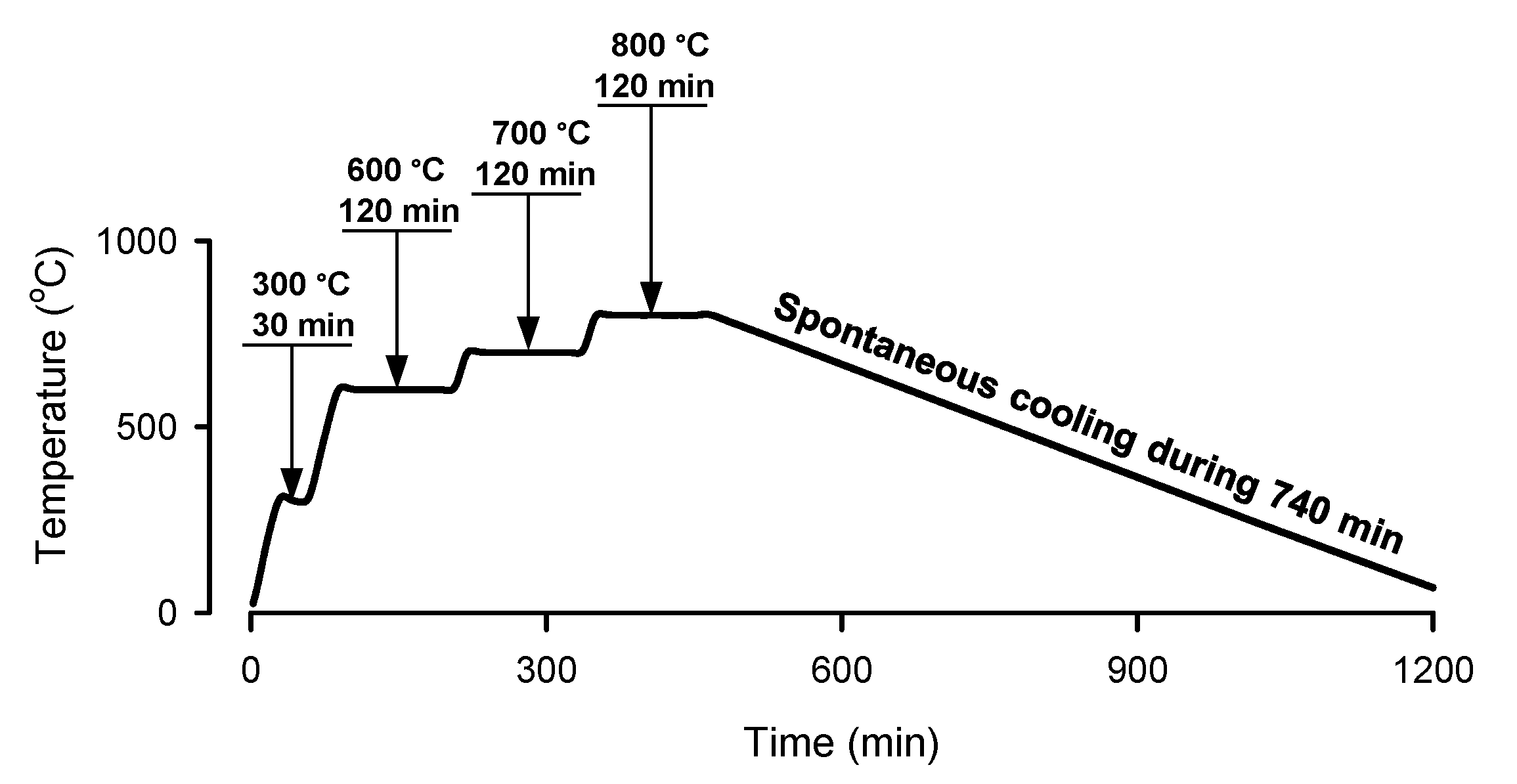
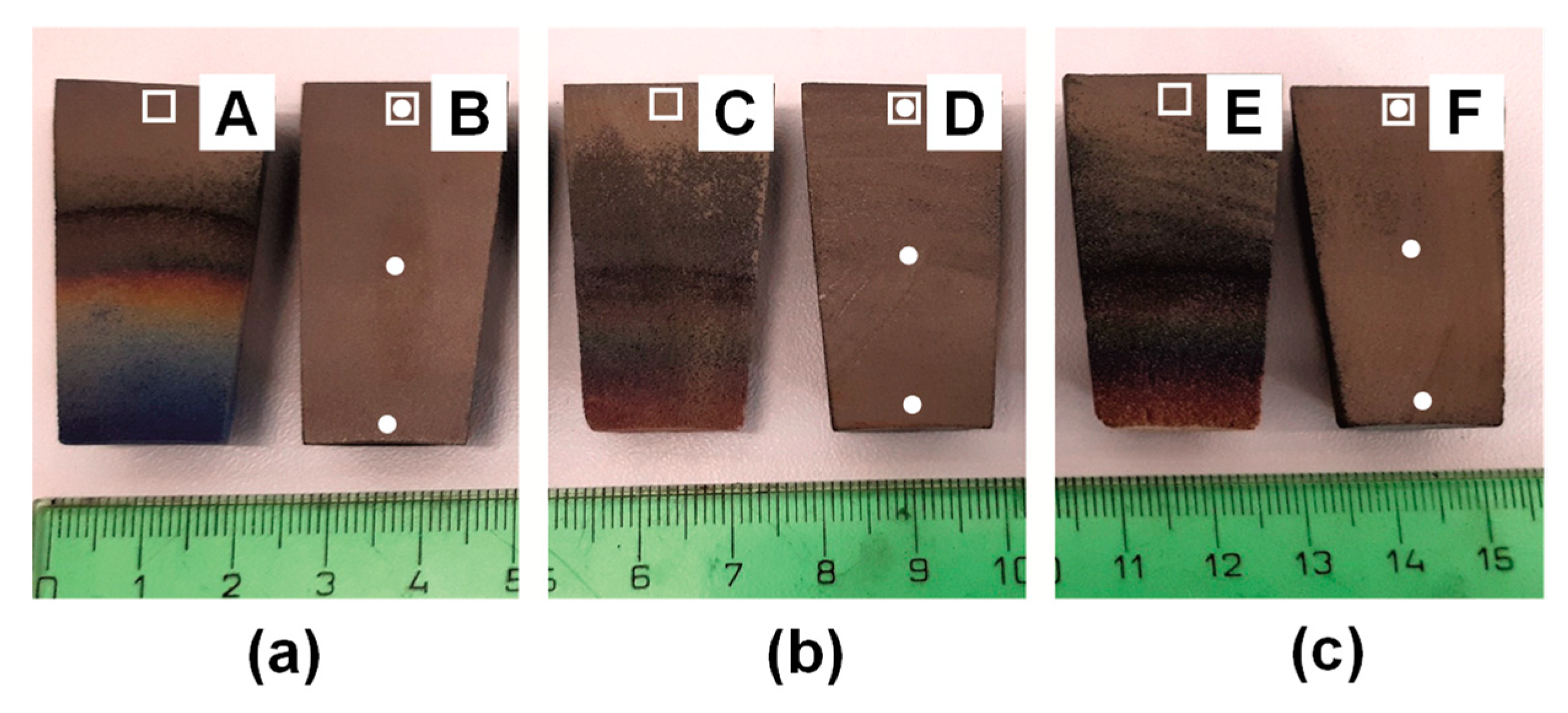
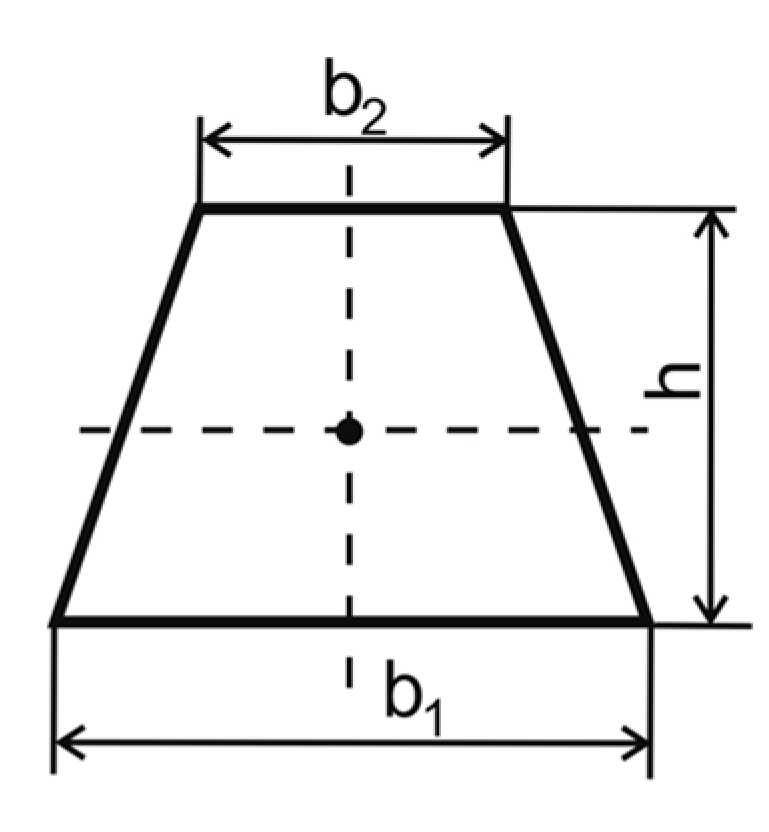


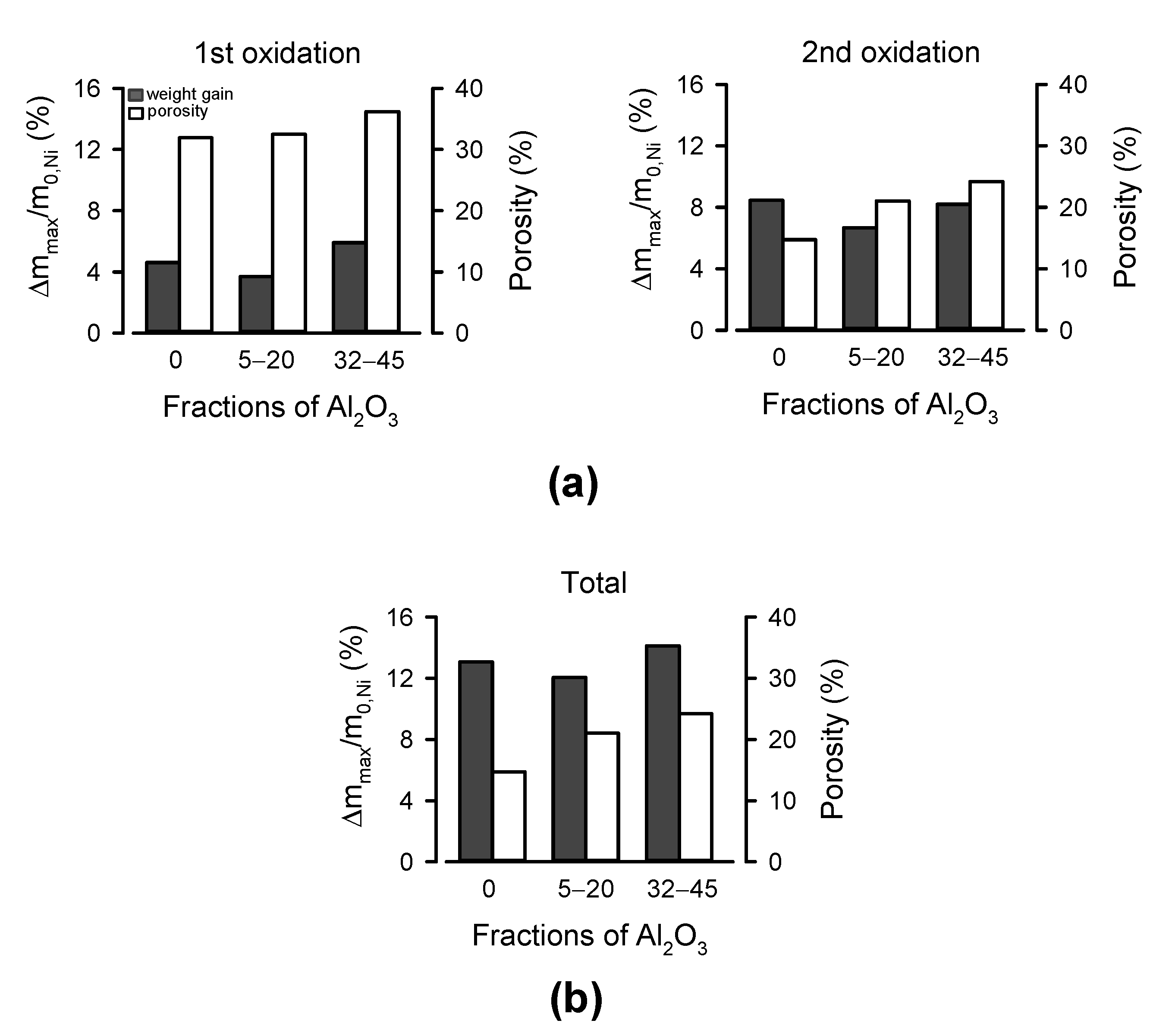



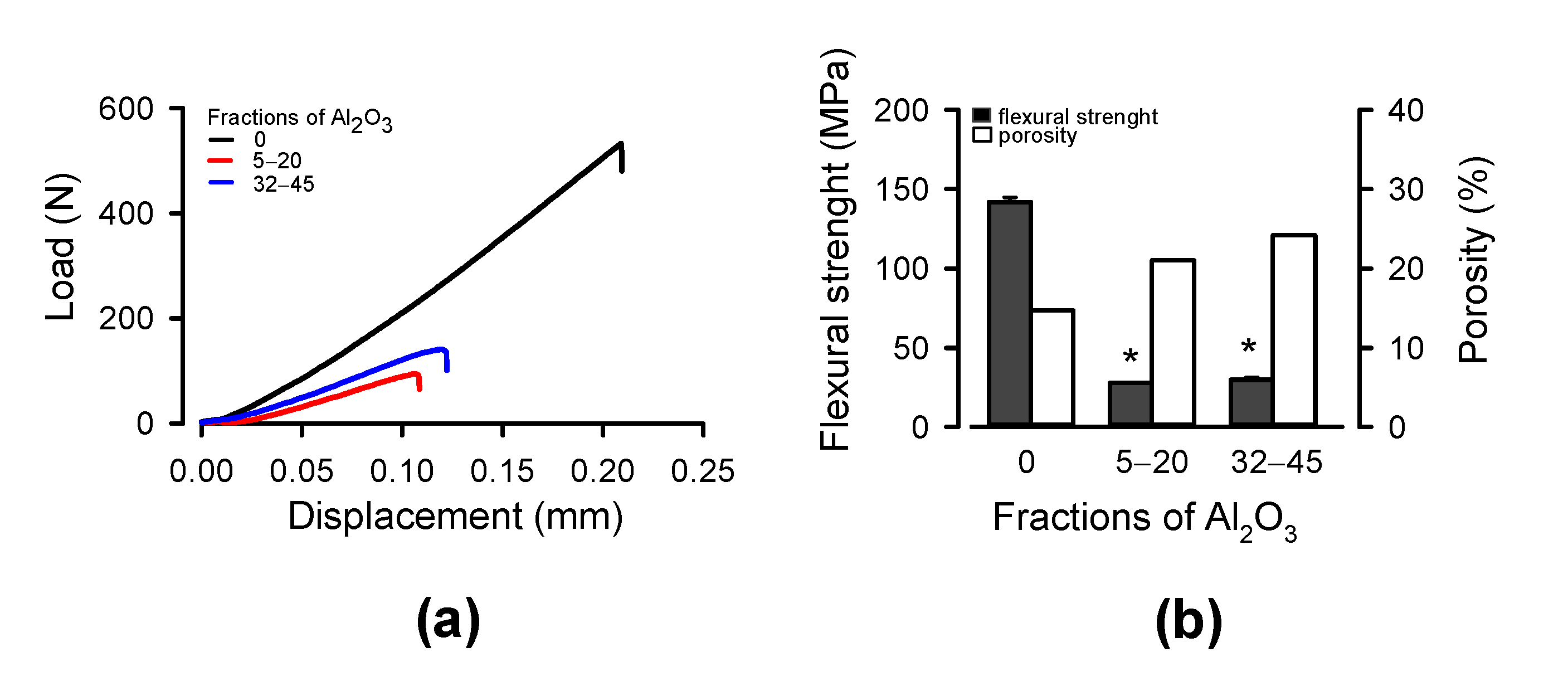
Publisher’s Note: MDPI stays neutral with regard to jurisdictional claims in published maps and institutional affiliations. |
© 2021 by the authors. Licensee MDPI, Basel, Switzerland. This article is an open access article distributed under the terms and conditions of the Creative Commons Attribution (CC BY) license (https://creativecommons.org/licenses/by/4.0/).
Share and Cite
Opálek, A.; Gaburjáková, M.; Švec, P.; Kúdela, S., Jr.; Štĕpánek, M.; Štefánik, P.; Iždinský, K. Impact of Al2O3 Particle Size on the Open Porosity of Ni/Al2O3 Composites Prepared by the Thermal Oxidation at Moderate Temperatures. Metals 2021, 11, 1582. https://doi.org/10.3390/met11101582
Opálek A, Gaburjáková M, Švec P, Kúdela S Jr., Štĕpánek M, Štefánik P, Iždinský K. Impact of Al2O3 Particle Size on the Open Porosity of Ni/Al2O3 Composites Prepared by the Thermal Oxidation at Moderate Temperatures. Metals. 2021; 11(10):1582. https://doi.org/10.3390/met11101582
Chicago/Turabian StyleOpálek, Andrej, Marta Gaburjáková, Peter Švec, Stanislav Kúdela, Jr., Matej Štĕpánek, Pavol Štefánik, and Karol Iždinský. 2021. "Impact of Al2O3 Particle Size on the Open Porosity of Ni/Al2O3 Composites Prepared by the Thermal Oxidation at Moderate Temperatures" Metals 11, no. 10: 1582. https://doi.org/10.3390/met11101582





